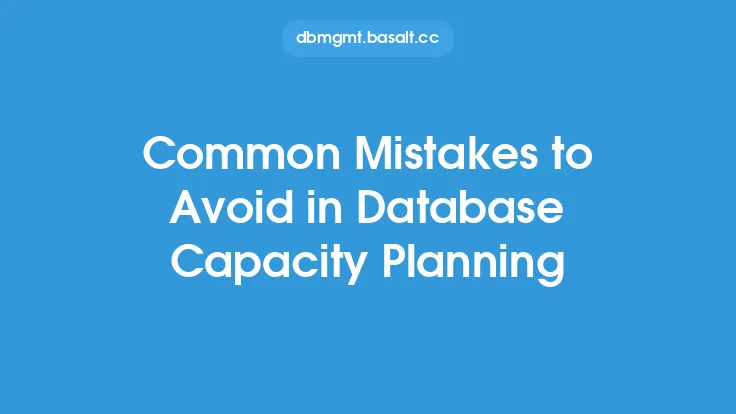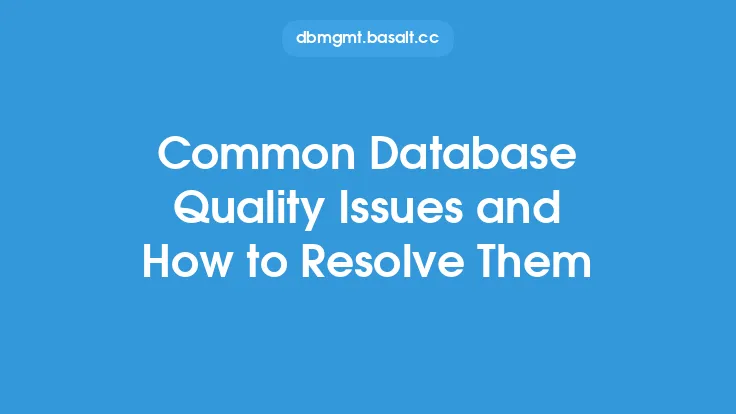When it comes to optimizing database queries, there are several common mistakes that can hinder performance and lead to suboptimal results. These mistakes can be costly, not only in terms of query execution time but also in terms of system resources and overall database performance. In this article, we will explore some of the most common query optimization mistakes and provide guidance on how to avoid them.
Understanding the Importance of Indexing
One of the most critical aspects of query optimization is indexing. Indexes are data structures that improve the speed of data retrieval by providing a quick way to locate specific data. However, many developers and database administrators make the mistake of not creating indexes or creating them incorrectly. To avoid this mistake, it's essential to understand the different types of indexes, such as B-tree indexes, hash indexes, and full-text indexes, and how to create them effectively. For example, in MySQL, you can create an index using the `CREATE INDEX` statement, while in PostgreSQL, you can use the `CREATE INDEX` command with the `USING` clause to specify the index type.
Avoiding Over-Indexing
While indexing is crucial for query optimization, over-indexing can be detrimental to performance. Over-indexing occurs when too many indexes are created, leading to increased storage requirements, slower write performance, and increased maintenance costs. To avoid over-indexing, it's essential to carefully evaluate the queries that are executed most frequently and create indexes only on the columns that are used in the `WHERE`, `JOIN`, and `ORDER BY` clauses. Additionally, it's crucial to monitor index usage and remove any unused indexes to prevent unnecessary overhead.
The Pitfalls of Poorly Written Queries
Poorly written queries can significantly impact database performance, and one of the most common mistakes is using `SELECT \*` instead of specifying the required columns. This can lead to increased data transfer, slower query execution, and increased memory usage. To avoid this mistake, it's essential to specify only the required columns in the `SELECT` statement and use efficient join techniques, such as inner joins instead of cross joins. Furthermore, using efficient aggregation functions, such as `EXISTS` instead of `IN`, can also improve query performance.
Inadequate Statistics and Cost Estimation
Inadequate statistics and cost estimation can lead to suboptimal query plans, resulting in poor performance. To avoid this mistake, it's essential to regularly update table statistics and ensure that the cost estimation is accurate. In PostgreSQL, for example, you can use the `ANALYZE` command to update table statistics, while in MySQL, you can use the `ANALYZE TABLE` statement. Additionally, using tools like the query optimizer's `EXPLAIN` command can help identify potential issues with the query plan and provide insights into optimization opportunities.
Insufficient Resource Allocation
Insufficient resource allocation can significantly impact database performance, and one of the most common mistakes is not allocating sufficient resources to the database server. To avoid this mistake, it's essential to monitor system resources, such as CPU, memory, and disk space, and adjust the resource allocation accordingly. Additionally, using resource-intensive features, such as parallel query execution, can also improve performance, but requires careful planning and monitoring to avoid overloading the system.
Common Mistakes in Query Rewriting
Query rewriting is a powerful technique for improving query performance, but it can also lead to common mistakes. One of the most common mistakes is rewriting queries without considering the underlying data distribution. To avoid this mistake, it's essential to understand the data distribution and use techniques like query optimization hints to guide the query optimizer. Additionally, using tools like the query optimizer's `EXPLAIN` command can help identify potential issues with the query plan and provide insights into optimization opportunities.
Best Practices for Query Optimization
To avoid common query optimization mistakes, it's essential to follow best practices, such as regularly monitoring query performance, using efficient indexing techniques, and optimizing queries based on actual data distribution. Additionally, using tools like query optimization software can help identify potential issues and provide recommendations for improvement. By following these best practices and avoiding common mistakes, developers and database administrators can improve query performance, reduce system resources, and enhance overall database performance.
Conclusion
Query optimization is a critical aspect of database performance optimization, and avoiding common mistakes is essential for achieving optimal results. By understanding the importance of indexing, avoiding over-indexing, writing efficient queries, maintaining adequate statistics and cost estimation, allocating sufficient resources, and following best practices, developers and database administrators can improve query performance, reduce system resources, and enhance overall database performance. By being aware of these common mistakes and taking steps to avoid them, you can ensure that your database queries are optimized for performance and that your database is running at its best.





